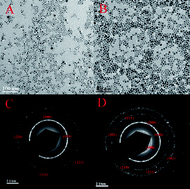Monodisperse NaYbF4 : Tm3+/NaGdF4 core/shell nanocrystals with near-infrared to near-infrared upconversion photoluminescence and magnetic resonance properties†
Abstract
We report core/shell NaYbF4 : Tm3+/NaGdF4

- This article is part of the themed collection: Optical Materials

 Please wait while we load your content...
Please wait while we load your content...